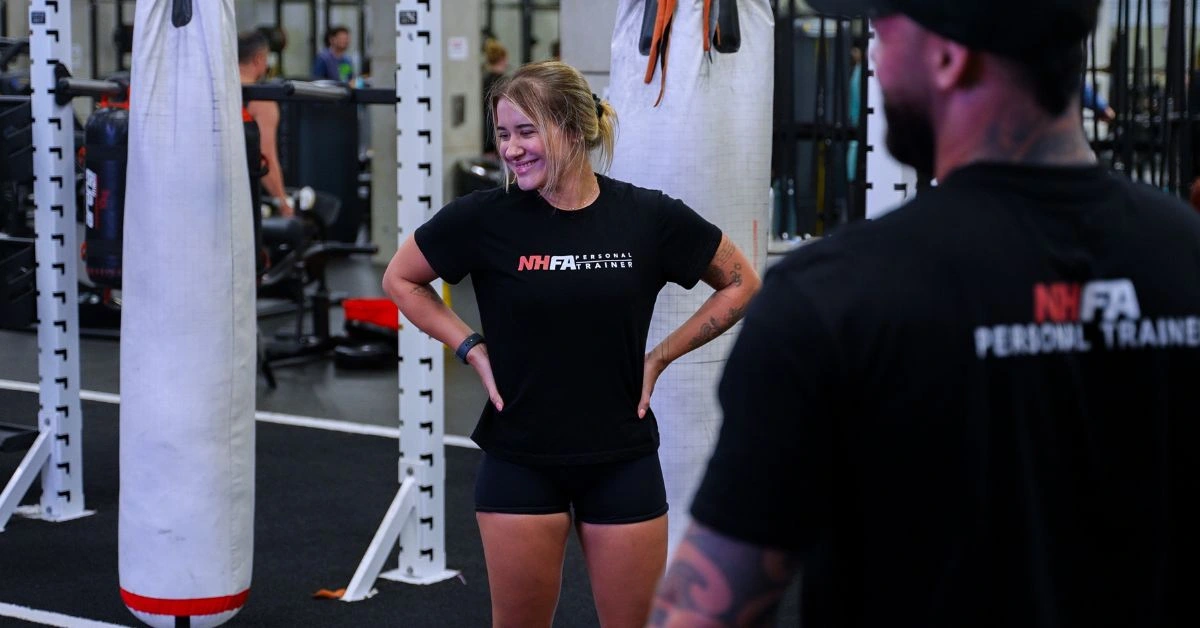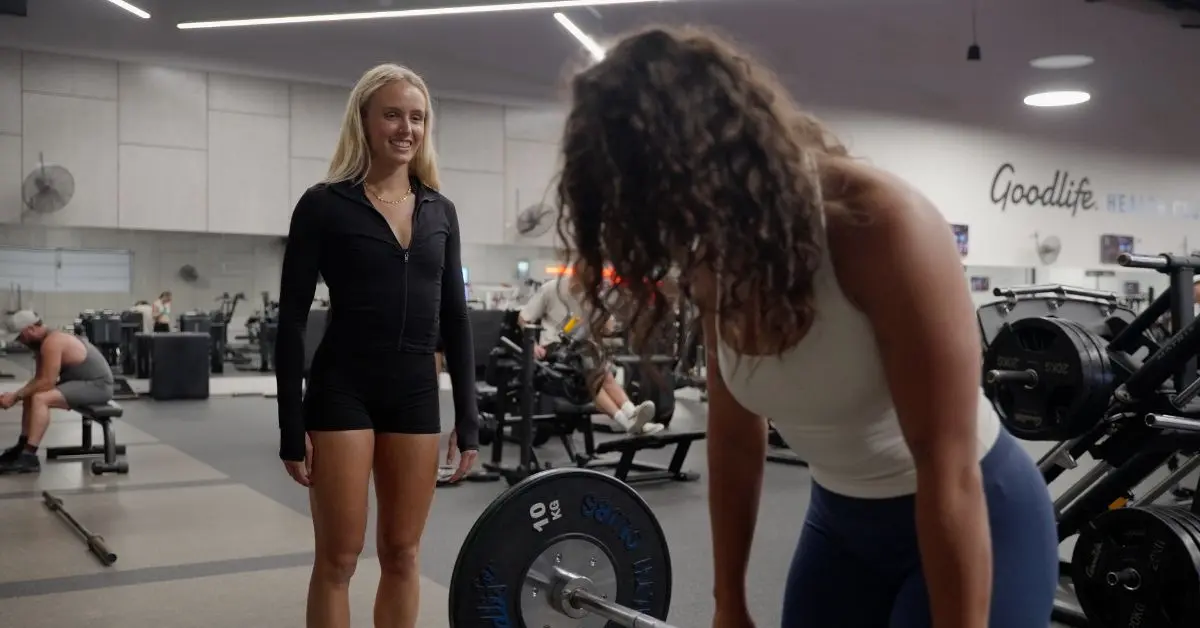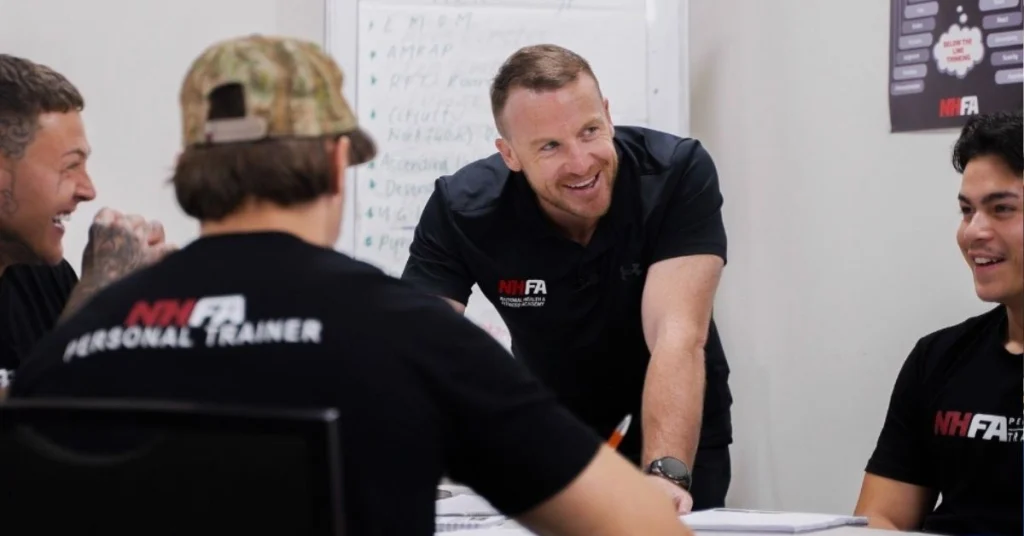
Becoming a Personal Trainer is about more than enjoying fitness. It’s about helping others improve their health, confidence, and overall quality of life. A personal trainer works with people of all ages and abilities, designing safe and effective programs that support real-world goals, whether that’s strength, rehabilitation, or general wellbeing.
Many people are drawn to this career because it blends passion and purpose. It can offer flexible work, meaningful client relationships, and the satisfaction of seeing progress firsthand. Yet, success in the fitness industry requires more than motivation. It depends on accredited qualifications, practical skills, and a clear understanding of how the industry operates.
This guide explains every stage of becoming a Personal Trainer in Australia. You’ll learn which qualifications are required, how to choose the right course, what early career roles look like, and how to develop the professional skills that lead to long-term success. We’ll also touch on related learning pathways, including business development for trainers who plan to run their own studios, and nutrition coaching for those who want to broaden their expertise.
Whether you’re just starting out or looking to upskill, use this step-by-step guide to understand what’s involved; from your first enrolment decision to building a sustainable, rewarding career in fitness.
Personal Trainer vs Fitness Instructor
Before enrolling in a fitness qualification, it’s important to understand the difference between a Fitness Instructor and a Personal Trainer.
Both play vital roles in helping people improve their health and wellbeing, but their qualifications, responsibilities, and work environments differ.
Role
Qualification
Focus
Typical Workplace
Fitness Instructor
Group exercise, gym supervision, member support
Gyms, studios, community programs
Personal Trainer
One-on-one and small-group coaching, advanced program design, client management
Gyms, private studios, mobile or online
A Fitness Instructor supports the daily operation of a gym-leading classes, assisting members with technique, and maintaining safety on the floor.
A Personal Trainer, on the other hand, provides individualised programs, goal-specific assessments, and long-term client support. Many trainers operate independently or run their own business.
Knowing this distinction will help you choose the qualification that best matches your career goals and how you want to work in the industry.

What Does a Fitness Instructor Do?
A Fitness Instructor introduces people to structured exercise in a safe, supportive environment.
They play an essential role in helping members develop confidence and consistency before moving into more advanced or personalised programs.
Daily tasks may include:
- Leading group classes such as circuit, HIIT, or bootcamp
- Supervising members on the gym floor and correcting technique
- Setting up and maintaining equipment
- Supporting member inductions and general fitness advice
Fitness Instructors are often the first point of contact for new members, which makes communication and enthusiasm key to their success. Many instructors later advance their careers by completing the Certificate IV in Fitness and becoming qualified Personal Trainers.

What Does a Personal Trainer Actually Do?
A Personal Trainer works closely with individuals and small groups to design, deliver, and review safe and effective exercise programs.
Their role goes beyond counting repetitions or demonstrating techniques. They assess client needs, set realistic goals, and provide guidance that helps people move better, feel stronger, and improve their overall wellbeing.
Typical responsibilities include:
- Conducting health and fitness assessments
- Planning exercise sessions based on goals and ability
- Monitoring progress and adjusting programs
- Teaching correct technique and equipment use
- Supporting motivation, mindset, and healthy lifestyle habits
Personal Trainers often work in gyms, studios, and outdoor environments, and many branch into specialised coaching or business ownership. Their work is people-focused, requiring not only technical knowledge but also communication skills, empathy, and professionalism.
Minimum Qualifications in Australia
In Australia, fitness professionals must hold nationally recognised qualifications delivered by a Registered Training Organisation (RTO). These align with the Australian Qualifications Framework (AQF) and ensure consistency across the industry.
Certificate III in Fitness (SIS30321)
This qualification prepares you for entry-level roles such as gym instructor, group exercise leader, or member support assistant. Graduates can supervise the gym floor, deliver group classes, and support clients in general fitness programs. However, Certificate III alone does not qualify you to provide one-to-one personal training sessions.
Certificate IV in Fitness (SIS40221)
This is the minimum qualification required to work independently as a Personal Trainer in most gyms and studios. It covers advanced program design, client assessment, small-group training, and business fundamentals relevant to running personal training services. Many students complete both Certificate III and Certificate IV in sequence to become fully qualified.
(Explore these in more detail in our Certificate III & IV Fitness Qualifications article.)
Additional Requirements
- First Aid and CPR: Most employers require current certification.
- Professional insurance and registration: Industry bodies may offer coverage and continuing education.
- Continual development: Trainers are encouraged to maintain skills and stay updated with exercise science, safety standards, and ethical practice.

Choosing How to Study
Fitness qualifications can be delivered in several ways — face-to-face, online, or blended (a mix of both). Each method offers different benefits and challenges.
- Face-to-face learning provides supervised practice and immediate feedback, which helps students develop confidence and technique.
- Online study offers flexibility, but students need strong self-motivation and often fewer practical opportunities.
- Blended programs combine the two and may include set practical workshops alongside online theory modules.
When comparing training options, consider:
- Practical hours and hands-on experience
- Access to real gym environments
- Trainer qualifications and support availability
- Assessment methods (written, observation, or portfolio)
- Pathways for ongoing mentorship and networking
Selecting a delivery mode that matches your learning style and career goals is crucial. Practical exposure during your study will make it easier to transition into work confidently once you’re qualified.
If you’re still comparing courses, it’s worth taking time to understand how qualification level, study delivery, and RTO accreditation influence the overall cost and quality of your training. Course fees can vary depending on the provider, inclusions, and support offered.
You can explore this in more detail in our guide: How to Understand Fitness Course Fees in Australia
Common Mistakes to Avoid
Studying to become a Personal Trainer is a major commitment of both time and money, and small decisions early on can shape your long-term success. Many students share the same early challenges: choosing the wrong course format, overlooking the trainer’s expertise, or not thinking ahead to where they want to work.
Here are three common mistakes to avoid before you enrol:
1. Choosing a course only by its price
It’s natural to compare course fees, but the lowest price doesn’t always represent the best value. Fitness qualifications differ in delivery, support, and practical learning opportunities.
When choosing a provider, focus on the value of the education rather than the upfront cost. A quality learning environment, clear practical structure, and ongoing feedback will make the qualification far more worthwhile.
If you’re weighing up price versus quality, read our article as to why the lowest price Isn’t always the best investment.
2. Overlooking the expertise of the coaches and educators
Who teaches your course can make as much difference as the content itself. Trainers who are active in the fitness industry bring real-world examples, problem-solving strategies, and communication techniques that you can’t always gain through online videos or written modules alone.
Look for programs that involve direct interaction with qualified assessors, structured feedback, and opportunities to practise skills in a live setting. This hands-on guidance helps bridge the gap between theory and real client work: something that’s hard to replicate in a purely online course.
3. Forgetting the bigger picture: where you want to work
Before enrolling, think about the type of environment you’d like to work in once you’re qualified.
Do you see yourself training clients in a gym, running outdoor sessions, or offering online programs?
Understanding this early helps you choose the right course structure, assessment style, and industry exposure.
Networking is also a key part of long-term success. Students who connect with peers, trainers, and fitness centres during their studies often find it easier to secure work or mentorship opportunities later.
Avoiding these early mistakes sets the foundation for a smoother study experience and a stronger transition into the industry. Choosing the right training environment and support system from the start can make all the difference in how confident you feel stepping into your first role.
NHFA Founder & Director, Dave Burgis, explaining the biggest mistakes people make when studying Personal Training in detail.
Skills Beyond the Certificate
Completing your qualification is only the beginning. The next stage is developing the mindset and practical systems that allow you to build and maintain a career. Many new trainers enter the industry full of enthusiasm, yet quickly realise that success depends on more than program design or training knowledge.
Professionalism and Confidence in Practice
Professionalism starts with accountability. Set clear expectations with clients, then follow through on what you promise. Small actions build trust, and trust builds your reputation.
Confidence grows from competence. The more you understand program design, cueing, safety, and progression, the less you need to “act” confident. Prepare thoroughly, practise your craft, and review your sessions. Familiarity reduces nerves, especially before assessments, new client intakes, or group classes.
Be authentic. Clients respond to trainers who are honest about what they know and who refer when a goal sits outside their scope. Genuine confidence comes from knowledge, not performance.
Practical habits to start this week:
- Set expectations in writing: session inclusions, check-in rhythm, and cancellation rules.
- Prepare for every session: plan the session, regressions, and progressions.
- Reflect for ten minutes after your shift: what worked, what to improve, what to repeat.
- Keep learning: schedule one hour for continuing education or mentor feedback.

Focus on what makes the biggest difference
When starting out, it’s easy to get caught up in details such as branding, social media, or logo design. These can be enjoyable tasks but rarely drive early progress. The first priority should always be the process, identifying the single most important actions that will move you forward each week.
Ask yourself:
- What will make the biggest difference today?
- What do I need to do, rather than what I prefer to do?
Building this discipline early helps trainers stay consistent, organised, and outcome-focused.
Learn the systems behind a successful business
Personal Trainers are often self-employed or work as contractors, which means managing many areas of small-business operation. Even basic systems can help keep things manageable. Examples include:
- Lead generation: knowing where new clients come from and how to track enquiries.
- Client management: keeping records, assessments, and communication organised.
- Scheduling and payments: using software or simple templates to handle bookings and billing.
- Goal setting and review: establishing targets for client sessions, retention, and personal income.
Understanding and refining these systems makes it easier to focus on coaching rather than constantly reacting to problems. It also lays the groundwork for later growth, whether that means moving into studio management, online coaching, or running a team of trainers.
(You can explore structured guidance on this topic in our related article: Investing in Your Fitness Business Education)
Developing planning and reflection habits
A clear plan prevents overwhelm. Break large goals into smaller, measurable steps and review them regularly. Consistent reflection: even ten minutes at the end of the week helps identify what’s working and what needs attention.
Trainers who treat their profession as an ongoing learning process tend to progress faster and adapt more easily to industry changes.
NHFA Founder & Director Dave Burgis – The most important thing new Personal Trainers and Fitness Coaches need to focus on
Is the Market Really Saturated?
It’s common to hear that there are “too many Personal Trainers” in Australia. At first glance, it can appear that way: gyms are full, social media is crowded, and online coaches seem to appear daily. Yet the reality is more nuanced. The fitness industry continues to expand, and demand for quality trainers remains steady across a wide range of settings.
Understanding the perception
Concerns about a “flooded market” often stem from two factors: visibility and turnover. Many people study fitness because they love training, but not everyone stays in the profession long-term. Some treat it as a side role or transition into related areas such as group fitness, allied health, or management. This constant movement can create the impression that competition is higher than it really is.
The role of quality and professionalism
Employers and clients look for trainers who demonstrate reliability, communication skills, and a strong understanding of safe, evidence-based training. Having a qualification is essential, but success depends on the quality of education and how effectively those skills are applied in practice. Trainers who can design progressive programs, deliver consistent results, and build genuine rapport often find no shortage of work.
NHFA Founder & Director Dave Burgis – Opportunities in the industry and whether the market is flooded.
Where the opportunities are
The demand for fitness professionals extends beyond traditional gyms. Opportunities exist in:
- Small group and boutique studios
- Outdoor and community training programs
- Workplace wellness initiatives
- Online and hybrid coaching models
- Resort, cruise, and recreation facilities
Each environment values different strengths, so identifying where your skills fit best can help you find your niche rather than competing broadly.
Mindset matters
The fitness industry rewards trainers who view their work as a long-term profession rather than a short-term pursuit. Building a client base, maintaining professional standards, and continuing education are what sustain careers, not market timing. Instead of focusing on how many trainers exist, concentrate on the experience you deliver and the trust you build with clients.

Career Pathways and Next Steps
Once you hold your nationally recognised fitness qualifications, the direction you take depends on your interests, strengths, and preferred work environment.
Some graduates enjoy leading energetic group sessions, while others prefer individual coaching or specialised education.
Below are four common pathways that show how a career in fitness can continue to grow and evolve:
1. Becoming a Fitness Instructor
The Certificate III in Fitness (SIS30321) provides entry into roles that focus on group instruction and member support.
Fitness Instructors may:
- Lead classes such as bootcamps, circuit, or small-group sessions
- Supervise the gym floor and assist clients with safe technique
- Deliver pre-programmed sessions in community, studio, or outdoor settings
This pathway suits people who enjoy working with larger groups and thrive on energy and interaction.
Instructors often work at commercial gyms, boutique studios, or recreation facilities, and many later progress into Personal Training through the Certificate IV in Fitness (SIS40221).
2. Building a Personal Training Business
After completing the Certificate IV in Fitness (SIS40221), you can work as a qualified Personal Trainer across a wide range of settings. This qualification prepares you to design individualised programs, coach clients one-on-one or in small groups, and adapt training to different goals and fitness levels.
Personal Trainers may:
- Deliver tailored exercise programs in gyms, studios, or outdoor environments
- Provide fitness assessments and progress tracking
- Educate clients on movement, motivation, and sustainable lifestyle habits
- Collaborate with allied health or wellness professionals when appropriate
Personal Training suits people who value deeper client relationships and the satisfaction of guiding long-term results. Trainers often work as employees within a gym or franchise, but many also choose to operate independently.
Some facilities run on an Independent Business Owner (IBO) model, where trainers rent space or pay a service fee to work with their own clients. This option offers greater flexibility and earning potential, but it also requires strong organisational and business management skills: scheduling, marketing, client communication, and record-keeping.
As you gain experience, professional development in areas such as client behaviour, leadership, and small-business operations can help you progress from hands-on coaching to studio management or mentorship roles.
(Related reading: Investing in Your Fitness Business Education)
3. Transitioning into Online Coaching
As digital platforms continue to grow, many qualified trainers are expanding their services through online coaching.
This model allows Personal Trainers to work with clients remotely, offering tailored programs, progress tracking, and accountability across any location or time zone.
It can complement in-person training or become a full-time business for those who value flexibility and autonomy.
(Related reading: Becoming an Online Fitness Coach)
4. Expanding into Nutrition Coaching
Many clients look for broader lifestyle guidance that includes both exercise and nutrition.
Although Personal Trainers can discuss general healthy-eating principles, specialised nutrition coaching requires targeted education delivered by qualified providers.
This pathway suits trainers who want to complement their fitness expertise with skills in behaviour change, meal planning education, and performance nutrition.
Combining coaching in fitness and nutrition can enhance client outcomes and career diversity.
(Related reading: Nutrition Coaching Is More Than Meal Plans)
5. Upskilling and Professional Development
The fitness industry evolves quickly, and ongoing learning keeps trainers competitive and confident.
Short courses, workshops, and continuing professional development (CPD) programs help trainers:
- Update knowledge in anatomy, technique, or special populations
- Learn about new equipment or training methodologies
- Refresh skills in communication and client motivation
Trainers who invest in professional growth maintain higher standards of service and open doors to advanced roles such as assessor, educator, or studio manager.
If you’re interested, NHFA features some excellent career development courses including our Business Mentorship and Certified Nutrition Coach programs.
Choosing a pathway isn’t about one right answer: it’s about aligning your interests with how you want to help others.
Many fitness professionals move between these options throughout their careers, combining roles or gradually building from group instruction into business ownership and specialised coaching.
NHFA Founder & Director, Dave Burgis, goes through Fitness Industry Options
If It’s Not Working: Troubleshooting your Fitness Business
Not every fitness career starts smoothly. Even after earning your qualification and putting in long hours on the gym floor, you might still feel stuck. Maybe client numbers aren’t growing, income fluctuates, or the excitement that drove you early on has started to fade. This doesn’t mean you’ve failed – it means your systems need attention.
Ask yourself:
- Are my goals clear and realistic?
- Do my business systems work consistently — from lead generation to client retention?
- Is my environment, such as the club or client base, helping or limiting my growth?
Running a personal training business is more than coaching sessions. It’s about building a network of systems that support you: marketing, client management, scheduling, and financial organisation. When even one part of that chain weakens, the whole business feels off balance. The good news is that most challenges are fixable once you know where to look.
Start with reflection. Ask yourself if you’re showing the same energy and ownership you had when you first qualified. Are your goals clear and measurable, or have they blurred over time? From there, review the structure of your business itself. Many trainers discover that inconsistent results come from weak lead generation, an unclear sales process, or poor client retention systems – not from lack of skill or passion.
Environment matters, too. Sometimes the gym or club you work in doesn’t align with your ideal clients, or mentorship is limited. If you’re constantly competing for floor space or feeling unsupported, it might be time to reassess where you’re building your client base.
For others, the issue lies in the business model. You might thrive with face-to-face coaching and community engagement, or you might prefer hybrid or online programs that let you expand your reach. Understanding which model fits your strengths often makes the biggest difference in motivation and income stability.
We’ve explored these patterns in more detail in our guide, Personal Trainer Business not working, Common Causes and Fixes. It breaks the process down into four parts: self-reflection, systems, environment, and model; to help you pinpoint what’s holding you back and plan meaningful changes. Small, consistent improvements often transform frustration into long-term progress.

Mindset and Longevity in the Industry
Discipline, reflection, and a professional attitude matter as much as technical skill. Long careers are built on habits that reduce guesswork and improve consistency.
Accountability builds trust
Follow through on what you promise. Be on time, deliver the agreed inclusions, and communicate early when plans change. Reliability is a competitive advantage.
Preparation reduces nerves
Nerves are normal before assessments, presentations, or first consultations. Preparation turns nerves into focus. Know the client goal, know your plan, and rehearse key cues.
Authenticity over performance
You do not need to pretend. If a goal requires another professional, refer appropriately and collaborate. Clients value honesty and a clear scope of practice.
Knowledge drives confidence
The quickest way to feel confident is to deepen your knowledge. Continue learning in areas that support your clients: technique, special populations, communication, and behaviour change. Knowledge removes the need for pretense.
Overcoming self-doubt
Self-doubt decreases with experience and review. Set small targets, track results, and celebrate visible wins with clients. Professional confidence grows from evidence, not slogans.
Start your success story today
PERSONAL TRAINING & FITNESS COURSES AUSTRALIA-WIDE
Schedule a quick call with our Course Advisors and get all of your questions answered!
Schedule Call

